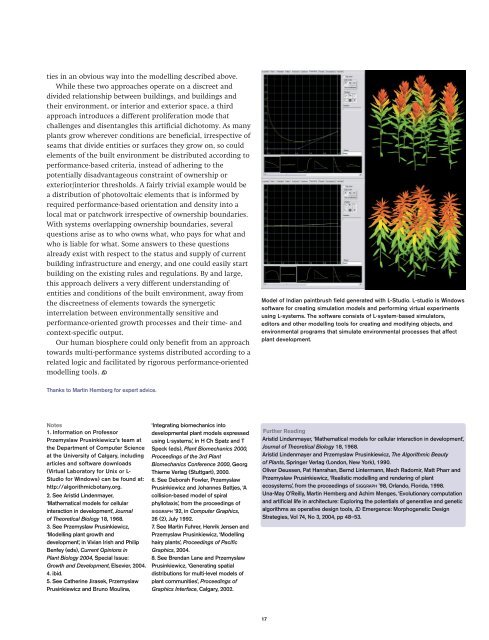Techniques and Technologies in Morphogenetic Design by Michael
Techniques and Technologies in Morphogenetic Design by Michael
Techniques and Technologies in Morphogenetic Design by Michael
Create successful ePaper yourself
Turn your PDF publications into a flip-book with our unique Google optimized e-Paper software.
ties <strong>in</strong> an obvious way <strong>in</strong>to the modell<strong>in</strong>g described above.<br />
While these two approaches operate on a discreet <strong>and</strong><br />
divided relationship between build<strong>in</strong>gs, <strong>and</strong> build<strong>in</strong>gs <strong>and</strong><br />
their environment, or <strong>in</strong>terior <strong>and</strong> exterior space, a third<br />
approach <strong>in</strong>troduces a different proliferation mode that<br />
challenges <strong>and</strong> disentangles this artificial dichotomy. As many<br />
plants grow wherever conditions are beneficial, irrespective of<br />
seams that divide entities or surfaces they grow on, so could<br />
elements of the built environment be distributed accord<strong>in</strong>g to<br />
performance-based criteria, <strong>in</strong>stead of adher<strong>in</strong>g to the<br />
potentially disadvantageous constra<strong>in</strong>t of ownership or<br />
exterior/<strong>in</strong>terior thresholds. A fairly trivial example would be<br />
a distribution of photovoltaic elements that is <strong>in</strong>formed <strong>by</strong><br />
required performance-based orientation <strong>and</strong> density <strong>in</strong>to a<br />
local mat or patchwork irrespective of ownership boundaries.<br />
With systems overlapp<strong>in</strong>g ownership boundaries, several<br />
questions arise as to who owns what, who pays for what <strong>and</strong><br />
who is liable for what. Some answers to these questions<br />
already exist with respect to the status <strong>and</strong> supply of current<br />
build<strong>in</strong>g <strong>in</strong>frastructure <strong>and</strong> energy, <strong>and</strong> one could easily start<br />
build<strong>in</strong>g on the exist<strong>in</strong>g rules <strong>and</strong> regulations. By <strong>and</strong> large,<br />
this approach delivers a very different underst<strong>and</strong><strong>in</strong>g of<br />
entities <strong>and</strong> conditions of the built environment, away from<br />
the discreetness of elements towards the synergetic<br />
<strong>in</strong>terrelation between environmentally sensitive <strong>and</strong><br />
performance-oriented growth processes <strong>and</strong> their time- <strong>and</strong><br />
context-specific output.<br />
Our human biosphere could only benefit from an approach<br />
towards multi-performance systems distributed accord<strong>in</strong>g to a<br />
related logic <strong>and</strong> facilitated <strong>by</strong> rigorous performance-oriented<br />
modell<strong>in</strong>g tools. 4<br />
Thanks to Mart<strong>in</strong> Hemberg for expert advice.<br />
Notes<br />
1. Information on Professor<br />
Przemyslaw Prus<strong>in</strong>kiewicz’s team at<br />
the Department of Computer Science<br />
at the University of Calgary, <strong>in</strong>clud<strong>in</strong>g<br />
articles <strong>and</strong> software downloads<br />
(Virtual Laboratory for Unix or L-<br />
Studio for W<strong>in</strong>dows) can be found at:<br />
http://algorithmicbotany.org.<br />
2. See Aristid L<strong>in</strong>denmayer,<br />
‘Mathematical models for cellular<br />
<strong>in</strong>teraction <strong>in</strong> development’, Journal<br />
of Theoretical Biology 18, 1968.<br />
3. See Przemyslaw Prus<strong>in</strong>kiewicz,<br />
‘Modell<strong>in</strong>g plant growth <strong>and</strong><br />
development’, <strong>in</strong> Vivian Irish <strong>and</strong> Philip<br />
Benfey (eds), Current Op<strong>in</strong>ions <strong>in</strong><br />
Plant Biology 2004, Special Issue:<br />
Growth <strong>and</strong> Development, Elsevier, 2004.<br />
4. ibid.<br />
5. See Cather<strong>in</strong>e Jirasek, Przemyslaw<br />
Prus<strong>in</strong>kiewicz <strong>and</strong> Bruno Moul<strong>in</strong>a,<br />
‘Integrat<strong>in</strong>g biomechanics <strong>in</strong>to<br />
developmental plant models expressed<br />
us<strong>in</strong>g L-systems’, <strong>in</strong> H Ch Spatz <strong>and</strong> T<br />
Speck (eds), Plant Biomechanics 2000,<br />
Proceed<strong>in</strong>gs of the 3rd Plant<br />
Biomechanics Conference 2000, Georg<br />
Thieme Verlag (Stuttgart), 2000.<br />
6. See Deborah Fowler, Przemyslaw<br />
Prus<strong>in</strong>kiewicz <strong>and</strong> Johannes Battjes, ‘A<br />
collision-based model of spiral<br />
phyllotaxis’, from the proceed<strong>in</strong>gs of<br />
SIGGRAPH ’92, <strong>in</strong> Computer Graphics,<br />
26 (2), July 1992.<br />
7. See Mart<strong>in</strong> Fuhrer, Henrik Jensen <strong>and</strong><br />
Przemyslaw Prus<strong>in</strong>kiewicz, ‘Modell<strong>in</strong>g<br />
hairy plants’, Proceed<strong>in</strong>gs of Pacific<br />
Graphics, 2004.<br />
8. See Brendan Lane <strong>and</strong> Przemyslaw<br />
Prus<strong>in</strong>kiewicz, ‘Generat<strong>in</strong>g spatial<br />
distributions for multi-level models of<br />
plant communities’, Proceed<strong>in</strong>gs of<br />
Graphics Interface, Calgary, 2002.<br />
Model of Indian pa<strong>in</strong>tbrush field generated with L-Studio. L-studio is W<strong>in</strong>dows<br />
software for creat<strong>in</strong>g simulation models <strong>and</strong> perform<strong>in</strong>g virtual experiments<br />
us<strong>in</strong>g L-systems. The software consists of L-system-based simulators,<br />
editors <strong>and</strong> other modell<strong>in</strong>g tools for creat<strong>in</strong>g <strong>and</strong> modify<strong>in</strong>g objects, <strong>and</strong><br />
environmental programs that simulate environmental processes that affect<br />
plant development.<br />
Further Read<strong>in</strong>g<br />
Aristid L<strong>in</strong>denmayer, ‘Mathematical models for cellular <strong>in</strong>teraction <strong>in</strong> development’,<br />
Journal of Theoretical Biology 18, 1968.<br />
Aristid L<strong>in</strong>denmayer <strong>and</strong> Przemyslaw Prus<strong>in</strong>kiewicz, The Algorithmic Beauty<br />
of Plants, Spr<strong>in</strong>ger Verlag (London, New York), 1990.<br />
Oliver Deussen, Pat Hanrahan, Bernd L<strong>in</strong>termann, Mech Radomir, Matt Pharr <strong>and</strong><br />
Przemyslaw Prus<strong>in</strong>kiewicz, ‘Realistic modell<strong>in</strong>g <strong>and</strong> render<strong>in</strong>g of plant<br />
ecosystems’, from the proceed<strong>in</strong>gs of SIGGRAPH ’98, Orl<strong>and</strong>o, Florida, 1998.<br />
Una-May O’Reilly, Mart<strong>in</strong> Hemberg <strong>and</strong> Achim Menges, ‘Evolutionary computation<br />
<strong>and</strong> artificial life <strong>in</strong> architecture: Explor<strong>in</strong>g the potentials of generative <strong>and</strong> genetic<br />
algorithms as operative design tools, 4 Emergence: <strong>Morphogenetic</strong> <strong>Design</strong><br />
Strategies, Vol 74, No 3, 2004, pp 48–53.<br />
17


